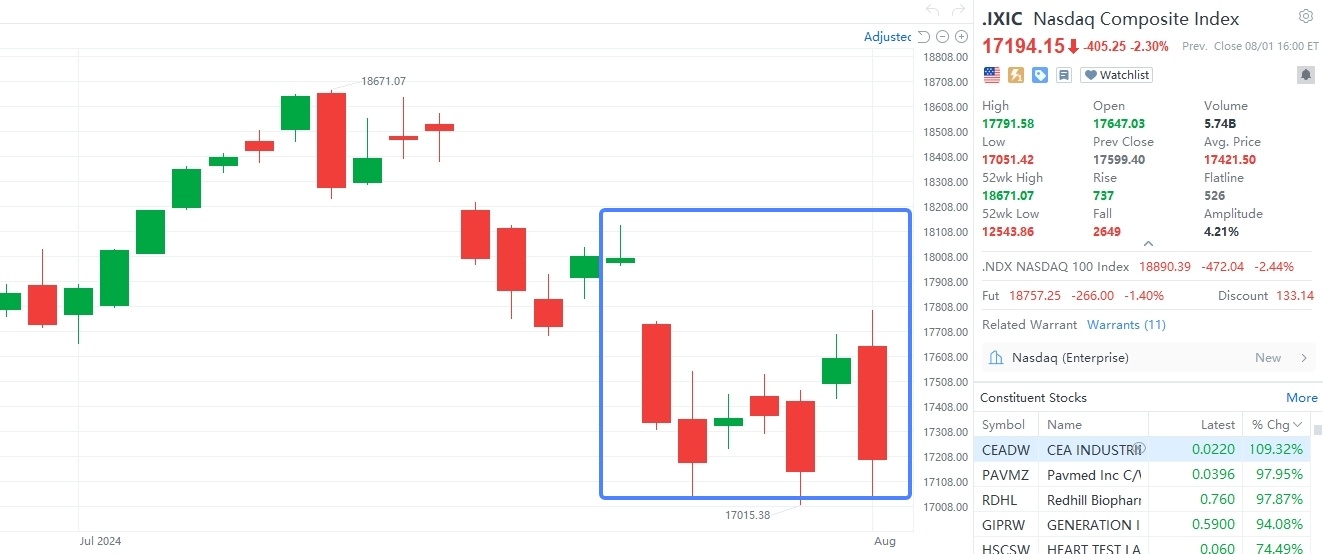Since Federal Reserve Chairman testified on Capitol Hill on July 11, the U.S. stock market has been unstable.
On July 24, we saw a 'Black Wednesday' with the S&P 500 dropping 2.3% and the Nasdaq plunging 3.64%—the worst since the AI boom began. 
After a brief stabilization this week, the U.S. stock market resumed its downward trend on Thursday, August 1, with the Nasdaq index falling more than 2%.

 Many investors are feeling blindsided and unsure of how to react. It's okay—let's take a moment to calm down and reassess our strategy.
Many investors are feeling blindsided and unsure of how to react. It's okay—let's take a moment to calm down and reassess our strategy.
Here are common responses to a market downturn:
1. Sell to cut losses
2. Implement hedging strategies
3. Stay put
4. Buy more or bottom-fish
Which one should you choose? Before making any decisions, we need to do two things: analyze the market outlook and evaluate our own situation.
 Market outlook
Market outlook
The market is flooded with analyses on the reasons behind the downturn, which can be viewed from both short-term and mid-term perspectives.
Short-term triggers
The immediate catalysts might be the earnings reports from tech stocks. While Apple and Meta beat the market's expectations, the financial reports of Google, Microsoft, and Amazon have raised doubts among investors about whether significant investments in AI are worthwhile.
Mid-term concerns
From a mid-term perspective, the market is mainly worried about the U.S. elections, economic slowdown, and doubts about the pace of AI commercialization—fears that resurface every time AI stocks decline.
While these concerns are valid, the core issue might be the previous significant market gains, prompting profit-taking and a needed correction.
Before the rate cut hits the ground in September, the market can possibly take advantage of the negative factors to complete a round of kills, and then go back to speculating on the rate cut.
 Want to bottom-fishing?
Want to bottom-fishing?
For investors considering bottom-fishing, the most important thing is to determine the turning point of this pullback.
A useful tool is the Fibonacci retracement, which is helpful to identify support levels during a pullback.
For example, Nvidia's first support is around $117 (23.6% retracement) and the second is around $102 (38.2% retracement). The stock has already breached the first level and is trending towards the second. If it stabilizes around $102, it could be a buying opportunity.

For more on using Fibonacci retracements, refer to this course: What are Fibonacci Retracements?

As we all know, predicting the market is always challenging, as anything can happen. If you lack confidence in the economy, elections, corporate earnings, or AI development, you should rule out bottom-fishing and consider the other strategies first. At this point, it's essential to evaluate your situation before making a decision.
 Ask Yourself These Questions
Ask Yourself These Questions
1. Am I losing money?
- Warren Buffett advised, "Rule No. 1: never lose money; Rule No. 2: never forget rule No. 1."
- If your stocks are nearing or starting to incur losses, sell immediately to protect your capital. It's better to miss an opportunity than to get stuck in a losing position.
2. Why did I buy this stock?
- Speculative investors: If you bought for short-term gains, exit quickly if the trend turns negative. Don’t switch to a long-term view just because the market is down.
- Long-term investors: Stay calm and assess if your original reasons for investing have changed. If they haven’t, continue to hold despite market panic.
3. Can I stay calm if the market moves against me?
Be prepared mentally for market fluctuations. One or two mistakes aren’t disastrous; the key is to stay rational.
- If you’re struggling: Consider selling and taking a break. Don’t rush back if the market rebounds, as this could lead to emotional decisions and further losses.
- If you’re holding but sensitive to fluctuations: Consider using hedging tools to reduce short-term risks and stay calm.
 Hedging tools
Hedging tools
If you already own stocks and don't want to sell at a loss, consider these hedging strategies:
1. Options Hedging
- Covered Call: Sell call options on your stocks. If the stock declines or remains flat, you earn the option premium. However, this offers limited protection in a significant downturn.

- Protective Put: Buy put options on your stocks for greater protection, but at a higher cost.
To find options on moomoo, go to Markets> Options
2. Inverse ETFs
Consider adding inverse ETFs to your portfolio. These ETFs rise as the market falls. $ProShares UltraPro Short QQQ ETF (SQQQ.US)$ and $Direxion Daily Semiconductor Bear 3x Shares ETF (SOXS.US)$ are good for tech-heavy portfolios. Be cautious with position sizes, as these ETFs will fall if the market rebounds, potentially leading to losses.
To find inverse ETFs on moomoo, go to Go to Markets> ETF> Index ETF> VIX> Inverse ETF
3. VIX ETFs
During sharp market declines, the VIX (volatility index) spikes. Trade VIX through ETFs like VXX and UVXY, which surged recently. These are suitable for short-term trading only, as long-term holding is risky.
To find these ETFs on moomoo: go to Markets> ETF> Index ETF> VIX
$S&P 500 Index (.SPX.US)$ $Dow Jones Industrial Average (.DJI.US)$ $Nasdaq Composite Index (.IXIC.US)$ $Tesla (TSLA.US)$ $NVIDIA (NVDA.US)$ $Alphabet-C (GOOG.US)$
Disclaimer: Moomoo Technologies Inc. is providing this content for information and educational use only. Read more
